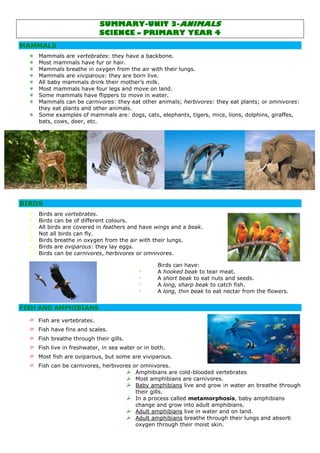
Unit 3 summary
- 1. SUMMARY-UNIT 3-ANIMALS SCIENCE – PRIMARY YEAR 4 MAMMALS Mammals are vertebrates: they have a backbone. Most mammals have fur or hair. Mammals breathe in oxygen from the air with their lungs. Mammals are viviparous: they are born live. All baby mammals drink their mother’s milk. Most mammals have four legs and move on land. Some mammals have flippers to move in water. Mammals can be carnivores: they eat other animals; herbivores: they eat plants; or omnivores: they eat plants and other animals. Some examples of mammals are: dogs, cats, elephants, tigers, mice, lions, dolphins, giraffes, bats, cows, deer, etc. BIRDS Birds are vertebrates. Birds can be of different colours. All birds are covered in feathers and have wings and a beak. Not all birds can fly. Birds breathe in oxygen from the air with their lungs. Birds are oviparous: they lay eggs. Birds can be carnivores, herbivores or omnivores. Birds can have: * A hooked beak to tear meat. * A short beak to eat nuts and seeds. * A long, sharp beak to catch fish. * A long, thin beak to eat nectar from the flowers. * FISH AND AMPHIBIANS ≈ Fish are vertebrates. ≈ Fish have fins and scales. ≈ Fish breathe through their gills. ≈ Fish live in freshwater, in sea water or in both. ≈ Most fish are oviparous, but some are viviparous. ≈ Fish can be carnivores, herbivores or omnivores. Amphibians are cold-blooded vertebrates Most amphibians are carnivores. Baby amphibians live and grow in water an breathe through their gills. In a process called metamorphosis, baby amphibians change and grow into adult amphibians. Adult amphibians live in water and on land. Adult amphibians breathe through their lungs and absorb oxygen through their moist skin.
- 2. INVERTEBRATES Invertebrates are all around us. Invertebrates don’t have a backbone. Invertebrates live on land and in water. Invertebrates walk, swim, crawl and fly. Many invertebrates have an exoskeleton, a shell or a soft body. INSECTS: Insects have an exoskeleton. Insects have their body divided into three parts: the head, the thorax and the abdomen. Insects have two antennae; six legs and most insects have wings. SPIDERS: Spiders have a body that is divided into two parts: the head and the abdomen. All spiders have eight legs. Most spiders have eight eyes, but some can have six, four or two eyes. CRABS: Crabs have ten legs and two eyes. Crabs usually move sideways. Crabs have a thick exoskeleton. REPTILES CENTIPEDES: Centipedes have lots of legs and many body parts. Centipedes have two antennae. Centipedes can move quickly. WORMS: Worms have a soft body that is divided into many parts. An earthworm has no lungs and breathes in oxygen through its moist skin. OCTOPUSES: Octopuses have a soft body and eight legs. They have a very good sense of touch in their suckers. SNAILS: Snails have a head with two tentacles and there is an eye at the end of each tentacle. Snails have a soft body that is protected by a shell. Reptiles were the first vertebrates to leave the water and live on land. Most reptiles have four limbs. Reptiles have scales. Reptiles breathe in oxygen with their lungs. Reptiles are cold-blooded. Most reptiles are oviparous and lay their eggs on land. Most reptiles are carnivores. SNAKES: Snakes need to lose a layer of skin as they grow. LIZARDS: Lizards need to replace their skin with new skin. Some lizards can also lose their tail to protect themselves from predators. It usually grows back. CROCODILES: The scales of crocodiles grow as the crocodile grows. Crocodiles can move quickly both on land and in water. TORTOISES: Tortoises have a shell. Tortoises live on land and are mostly herbivores. TURTLES: Turtles live in water. Turtles lay their eggs on land. Most turtles are omnivores